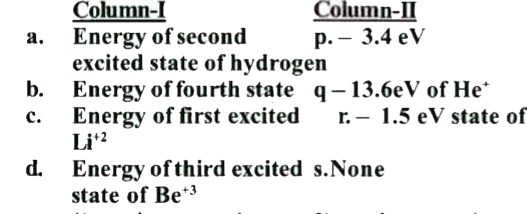Employin Thomson's model, calculate the radius of a hydrogen atom and wavelength of emitted light if the ionization energy of the atom is known to be equal to E=13.6eV
To solve the problem of calculating the radius of a hydrogen atom and the wavelength of emitted light using Thomson's model, we will follow these steps:
Step 1: Calculate the Radius of the Hydrogen Atom
1. Understanding Ionization Energy: The ionization energy (E) of hydrogen is given as 13.6 eV. This is the energy required to remove the electron from the atom.
2. Potential Energy Calculation: According to Thomson's model, the potential energy (U) of an electron in a hydrogen atom can be expressed as:
U=−ke2R
where k=14πϵ0 and R is the radius of the atom.
3. Setting Potential Energy Equal to Ionization Energy: The ionization energy is the negative of the potential energy when the electron is removed:
E=ke2R
4. Rearranging for R: Rearranging the equation to solve for R:
R=ke2E
5. Substituting Known Values: Now, substitute the known values:
- e (charge of electron) = 1.6×10−19 C
- k=14πϵ0≈8.99×109N m2/C2
- Convert E from eV to Joules: 1eV=1.6×10−19J so E=13.6eV=13.6×1.6×10−19J=2.176×10−18J
6. Calculating R:
R=(8.99×109)×(1.6×10−19)22.176×10−18
R≈0.159nmor1.59×10−10m
Step 2: Calculate the Wavelength of Emitted Light
1. Understanding the Emission Process: When the electron transitions from a higher energy state to a lower energy state, it emits a photon. The energy of the emitted photon corresponds to the difference in energy levels.
2. Using the Energy-Wavelength Relation: The energy of the emitted photon can be calculated using the formula:
E=hcλ
where h is Planck's constant (6.626×10−34Js) and c is the speed of light (3×108m/s).
3. Rearranging for Wavelength:
λ=hcE
4. Substituting Values:
λ=(6.626×10−34)×(3×108)2.176×10−18
5. Calculating Wavelength:
λ≈9.1×10−8mor91nm
Final Results
- Radius of Hydrogen Atom: R≈0.159nm
- Wavelength of Emitted Light: λ≈91nm
U=−ke2R
where k=14πϵ0 and R is the radius of the atom.
E=ke2R
R=ke2E
- e (charge of electron) = 1.6×10−19 C
- k=14πϵ0≈8.99×109N m2/C2
- Convert E from eV to Joules: 1eV=1.6×10−19J so E=13.6eV=13.6×1.6×10−19J=2.176×10−18J
R=(8.99×109)×(1.6×10−19)22.176×10−18
R≈0.159nmor1.59×10−10m
E=hcλ
where h is Planck's constant (6.626×10−34Js) and c is the speed of light (3×108m/s).
λ=hcE
λ=(6.626×10−34)×(3×108)2.176×10−18
λ≈9.1×10−8mor91nm
- Radius of Hydrogen Atom: R≈0.159nm
- Wavelength of Emitted Light: λ≈91nm
Topper's Solved these Questions
- ATOMIC AND NUCLEAR PHYSICSBOOK - IE IRODOV, LA SENA & SS KROTOVCHAPTER - ATOMIC AND NUCLEAR PHYSICSEXERCISE - Wave Properties Of Particle
48 Videos
- ATOMIC AND NUCLEAR PHYSICSBOOK - IE IRODOV, LA SENA & SS KROTOVCHAPTER - ATOMIC AND NUCLEAR PHYSICSEXERCISE - Properties Of Atom
69 Videos
- DIRECT CURRENTBOOK - IE IRODOV, LA SENA & SS KROTOVCHAPTER - DIRECT CURRENTEXERCISE - All Questions
15 Videos
Similar Questions
Knowledge Check
The ionization potential of hydrogen atom is 13.6 eV. The wavelength of the energy radiation required for the ionization of H-atom
A1911 nmB912 nmC68 nmD91.2nmThe ground state energy of hydrogen atom is −13.6eV. What is the potential energy of the electron in this state ?
A0eVB13.6 eVC27.2 eVD−27.2eVThe ground state energy of hydrogen atom is - 13.6 eV. What is the potential energy of the electron in this state?
A0 eVB−27.2eVC1 eVD2 eV
The ionization potential of a hydrogen atom is 13.6 eV. What will be the energy of the atom corresponding to n=2?
View SolutionThe ionization energy of H-atom is 13.6 eV. The ionization energy of Li2+ ion will be:
View SolutionThe ionisation energy of H atom is 13.6eV The inoisation energy of Li2+ law will be
View SolutionExcitation energy of hydrogen atom is 13.6eV. Match the following .

View SolutionThe energy of hydrogen atom in its ground state is -13.6 eV , the energy of the level corresponding to n=7 is
View Solution
